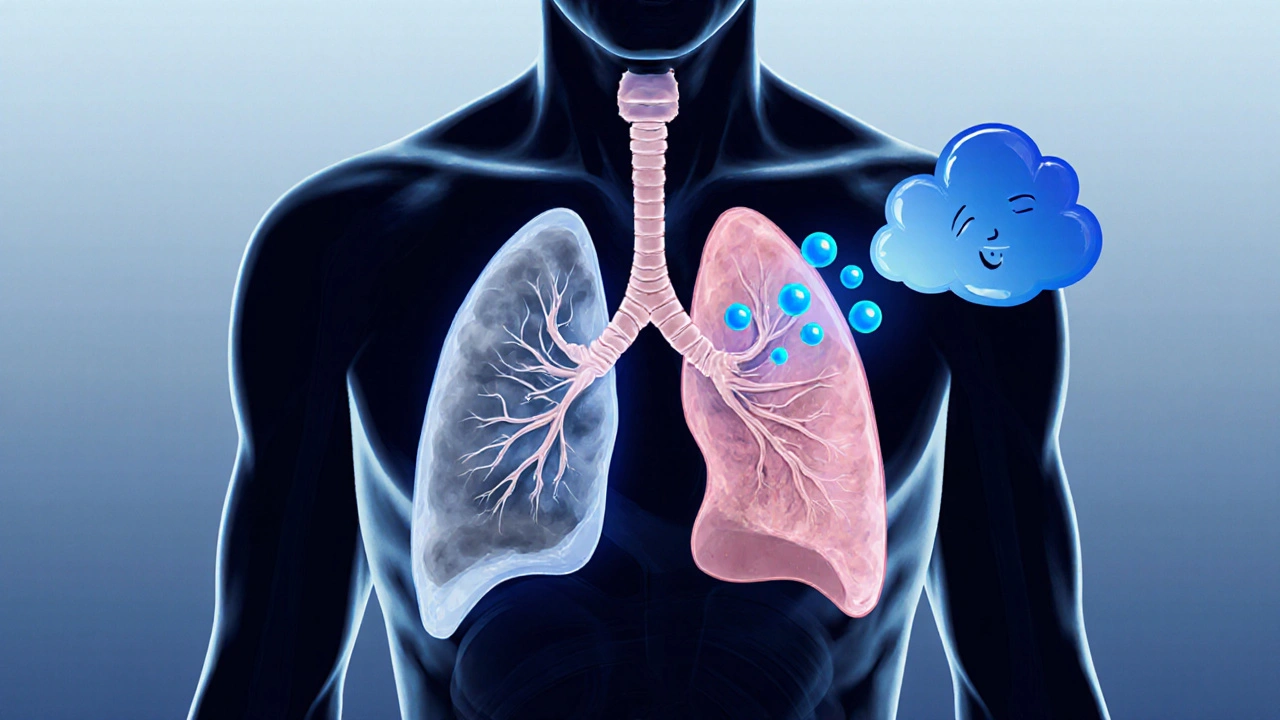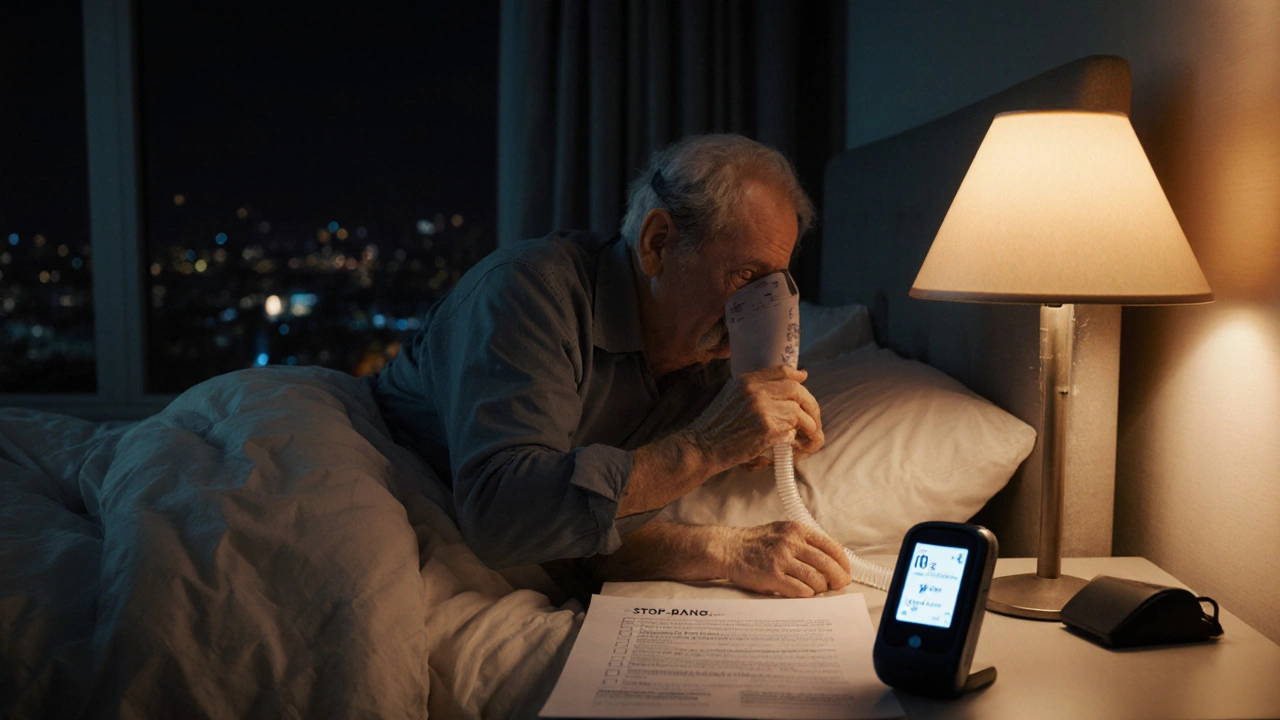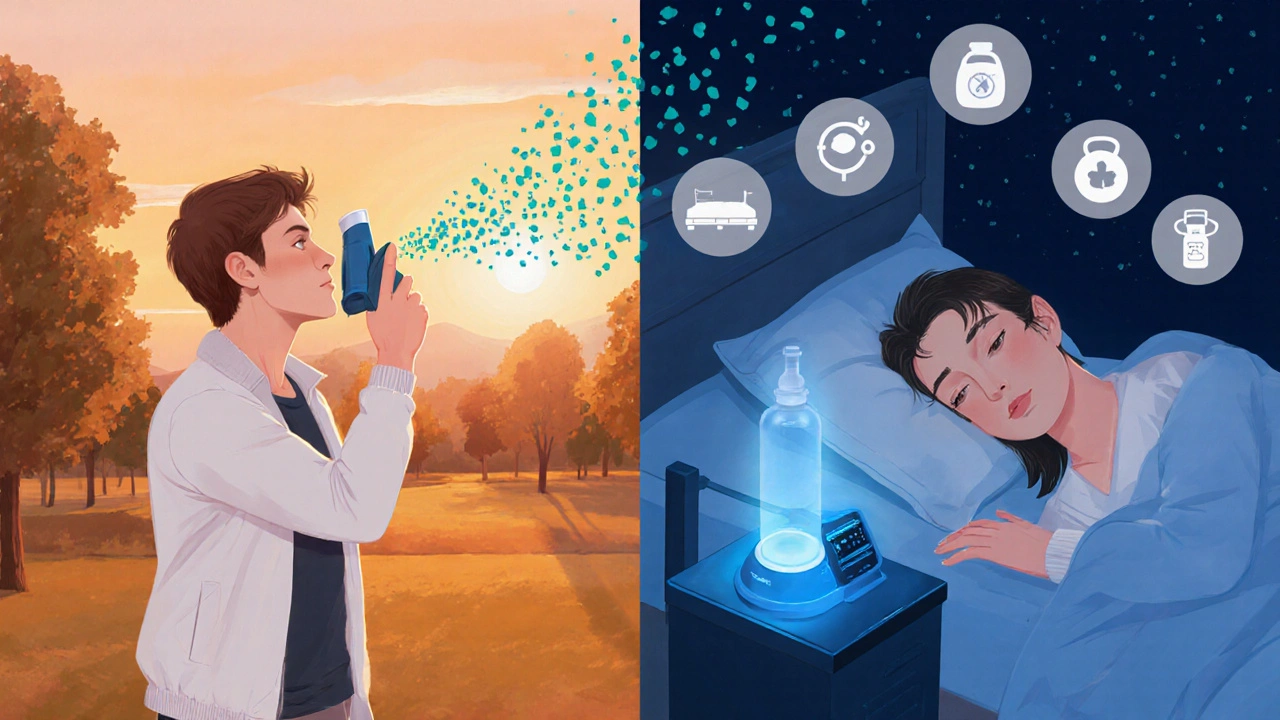
COPD and Sleep Apnea Overlap Risk Calculator
Enter Your Information
This tool estimates your risk of having overlap syndrome (COPD and sleep apnea together).
Your Overlap Syndrome Risk Assessment
Ever wondered why some people with chronic lung problems also snore loudly or wake up gasping? The link between COPD and sleep apnea isn‘t a coincidence - it’s a two‑way street that worsens symptoms, spikes risk of other diseases, and changes how doctors treat you.
Key Takeaways
- About 30% of COPD patients also have obstructive sleep apnea (OSA), a condition called overlap syndrome.
- Combined disease leads to lower night‑time oxygen, higher blood pressure, and more frequent flare‑ups.
- Screening tools like the STOP‑BANG questionnaire and overnight oximetry can catch OSA early.
- Treatment usually means a mix of COPD‑focused meds and sleep‑specific therapy such as CPAP.
- Lifestyle changes - quitting smoking, losing weight, and exercising - help both disorders.
Chronic Obstructive Pulmonary Disease is a progressive lung condition that makes it hard to exhale fully, leading to trapped air and chronic breathlessness. It’s most often caused by long‑term exposure to irritants like smoking or occupational dust.
Obstructive Sleep Apnea is a sleep‑related breathing disorder where the airway collapses repeatedly during sleep, causing pauses in breathing and sudden awakenings.
Why the Two Conditions Often Appear Together
There are three main reasons the diseases overlap:
- Shared risk factors. Smoking, older age, and obesity each increase the chance of developing COPD and OSA. A British study from 2023 showed that smokers over 55 had a 2.5× higher odds of having both conditions.
- Physiological interaction. COPD narrows the airways permanently, while OSA adds a temporary blockage each night. The result is compounded airway resistance and more severe drops in blood oxygen.
- Inflammatory cascade. Both illnesses trigger systemic inflammation. Elevated C‑reactive protein (CRP) and interleukin‑6 (IL‑6) levels have been recorded in patients with “overlap syndrome,” indicating a common inflammatory pathway.
How Overlap Syndrome Changes Your Health
When COPD and OSA coexist, you’re looking at a higher risk profile than either disease alone.
- Nocturnal oxygen desaturation. Night‑time oxygen levels can fall below 88% for longer periods, stressing the heart and brain.
- Pulmonary hypertension. Chronic low oxygen raises pressure in the pulmonary arteries, sometimes leading to right‑heart failure.
- Frequent exacerbations. A 2022 European Respiratory Journal analysis found that overlap patients had 1.8‑fold more COPD flare‑ups per year.
- Cardiovascular disease. The combination doubles the risk of stroke and coronary artery disease compared with COPD alone.

Spotting Overlap: Screening and Diagnosis
Because symptoms overlap, doctors rely on a mix of questionnaires, sleep studies, and simple home tests.
| Tool | What It Measures | Typical Cut‑off | Pros | Cons |
|---|---|---|---|---|
| STOP‑BANG | Snoring, Tiredness, Observed apnoea, Blood pressure, BMI, Age, Neck circumference, Gender | Score ≥3 | Quick, no equipment | May miss mild OSA |
| Home overnight oximetry | SpO₂ trends during sleep | ≥5% of sleep time < 90% SpO₂ | Affordable, easy at home | Doesn’t show airflow blockage |
| Polysomnography (PSG) | Full sleep study - brain waves, airflow, effort, oxygen | AHI ≥5 events/hr | Gold standard | Expensive, requires sleep lab |
For COPD patients, the American Thoracic Society now recommends a night‑time oximetry screen if they have persistent morning headaches, nocturnal choking, or unexplained fatigue.
Managing Both Conditions Together
Treatment isn’t just two separate plans slapped together; it’s a coordinated approach.
- Bronchodilators and inhaled steroids. Keep the airways open during the day and reduce inflammation that can worsen OSA episodes.
- Continuous Positive Airway Pressure (CPAP). A CPAP therapy delivers steady air pressure, preventing airway collapse at night. Studies in 2024 showed CPAP reduced COPD exacerbations by 27%.
- Oxygen supplementation. Low‑flow nocturnal oxygen (1‑2L/min) can raise night‑time SpO₂, but should be used only after a sleep study to avoid carbon‑dioxide retention.
- Lifestyle tweaks. Quitting smoking, losing 5‑10% of body weight, and regular moderate exercise improve lung function and reduce OSA severity.
- Vaccinations. Flu and pneumococcal shots lower infection‑driven exacerbations, which can otherwise trigger OSA‑related wake‑ups.
Common Pitfalls and How to Avoid Them
Even with the best guidelines, patients and clinicians often trip up.
- Assuming COPD meds fix OSA. Bronchodilators ease daytime breathing but don’t stop the airway collapse that occurs when you’re asleep.
- Skipping CPAP compliance checks. Many stop using CPAP after a few weeks because of mask discomfort. A proper mask fitting session and gradual pressure ramp can boost adherence.
- Over‑oxygenating. High flow oxygen can suppress the body’s drive to breathe, especially in COPD patients who rely on hypoxic drive. Always titrate oxygen under supervision.
- Ignoring weight loss. Even modest weight loss (≈7% of body weight) can lower the apnea‑hypopnea index (AHI) by 15‑20%.

What the Future Holds: Emerging Therapies
Researchers are testing a few promising strategies that could help overlap patients.
- Dual‑action inhalers. New formulations combine a long‑acting bronchodilator with an anti‑inflammatory that may also reduce upper‑airway edema.
- Adaptive servo‑ventilation (ASV). For patients who can’t tolerate CPAP, ASV automatically adjusts pressure to match breathing patterns. Early trials show improved night‑time oxygen without raising CO₂.
- Anti‑inflammasome drugs. Targeting IL‑6 and NLRP3 pathways could cut systemic inflammation that fuels both COPD and OSA.
Take Action Today
If you or a loved one has COPD, consider these concrete steps:
- Ask your doctor for a sleep questionnaire (STOP‑BANG) during your next visit.
- If the score is high, request a home oximetry test or a referral for polysomnography.
- Review your inhaler technique - a mis‑used inhaler can worsen night‑time breathing.
- Explore CPAP options early; many insurers cover the device if OSA is confirmed.
- Start a smoking‑cessation program - even cutting a few cigarettes a day can lower inflammation.
Remember, treating the overlap syndrome isn’t about juggling two separate diseases - it’s about seeing the whole picture and acting on the links that make them worse together.
Frequently Asked Questions
How common is overlap syndrome?
Studies from Europe and North America estimate that 20‑30% of people with COPD also meet criteria for obstructive sleep apnea. The prevalence rises to over 50% in patients with severe COPD.
Can CPAP make COPD symptoms worse?
When used correctly, CPAP typically improves night‑time oxygenation and reduces COPD exacerbations. Problems arise only if the pressure is set too high or if supplemental oxygen is over‑administered, leading to CO₂ retention.
Do I need a sleep study if I already use oxygen at night?
Yes. Oxygen alone doesn’t tell you whether the airway is collapsing. A sleep study will measure apnea events and guide whether CPAP, BiPAP, or other therapies are needed.
Is weight loss really that important for COPD patients?
For patients with overlap syndrome, excess weight worsens both airway obstruction and breathing mechanics. Losing 5‑10% of body weight can lower the apnea‑hypopnea index and reduce the work of breathing during the day.
What should I ask my doctor about vaccinations?
Ask whether you’re up to date on the annual flu shot and the pneumococcal vaccine (both PCV13 and PPSV23). These reduce the chance of infections that can trigger both COPD flare‑ups and worsening sleep apnea.
Stephen Nelson
October 7, 2025 AT 19:44Ah, because breathing should be a leisurely hobby, right?
Fredric Chia
October 8, 2025 AT 12:24The data presented underscores a significant comorbidity between COPD and OSA, yet the author neglects to quantify the impact of CPAP adherence on exacerbation rates. A rigorous meta‑analysis would be requisite to substantiate these claims.
Hope Reader
October 9, 2025 AT 05:04Thanks for the deep dive! It's refreshing to see sleep apnea finally getting the credit it deserves for ruining everyone's nights 😏.
Keep the tips coming, they're practically bedtime reading material.
Marry coral
October 9, 2025 AT 21:44Look, you sound like you’re reciting a textbook while ignoring the real‑world pain patients endure. Stop the jargon and tell us how to actually get better tonight.
Emer Kirk
October 10, 2025 AT 14:24so many stats i cant even keep up but i feel sooo lost
Anna Zawierucha
October 11, 2025 AT 07:04Bravo on the thoroughness; I almost expected a side‑quest to find the hidden CPAP treasure chest. Who needs dragons when you have nocturnal desaturations?
Mary Akerstrom
October 11, 2025 AT 23:44I hear you, the overwhelm is real and it’s okay to feel that way you’re not alone we’ve all been there and we’ll figure this out together
aishwarya venu
October 12, 2025 AT 16:24It’s fascinating how intertwined the inflammatory pathways are; perhaps future research will unveil a unified therapeutic target that could simplify management for patients.
Nicole Koshen
October 13, 2025 AT 09:04Your observation about a unified target is spot‑on. If we could modulate IL‑6 and NLRP3 concurrently, we might mitigate both airway obstruction and apnea‑related hypoxia, potentially reducing exacerbation frequency.
Ed Norton
October 14, 2025 AT 01:44Great points and practical steps thanks for keeping it concise.
Karen Misakyan
October 14, 2025 AT 18:24One might contend that the reductionist paradigm employed herein obscures the ontological complexity inherent in the dyadic relationship between chronic obstructive pulmonary disease and obstructive sleep apnea; a dialectical synthesis could yield a more comprehensive therapeutic schema.
Maude Rosièere Laqueille
October 15, 2025 AT 11:04Overlap syndrome, the coexistence of COPD and obstructive sleep apnea, is more than a simple additive burden; it creates a synergistic pathophysiology that demands a coordinated treatment plan.
First, clinicians should screen every COPD patient for sleep‑disordered breathing using the STOP‑BANG questionnaire, because early detection can prevent nocturnal hypoxemia.
If the score suggests moderate to high risk, a home overnight oximetry study is a cost‑effective next step before committing to polysomnography.
Polysomnography remains the gold standard, especially in patients with ambiguous oximetry results or co‑existing cardiac conditions.
Once OSA is confirmed, initiating CPAP therapy has been shown to reduce COPD exacerbation rates by roughly 27 % in recent trials.
It is crucial, however, to titrate CPAP pressures carefully, as excessive pressure can increase intrathoracic pressure and impede venous return, potentially worsening right‑heart strain.
In patients with severe hypercapnia, adding low‑flow nocturnal oxygen (1–2 L/min) can improve SpO₂ without suppressing hypoxic drive, provided arterial blood gases are monitored.
Concurrently, optimize COPD management by ensuring adherence to long‑acting bronchodilators and inhaled corticosteroids, which can lower airway inflammation that contributes to upper‑airway edema.
Smoking cessation remains the single most impactful intervention; even a modest reduction in cigarette consumption can decrease systemic inflammation markers such as CRP and IL‑6.
Weight management should not be overlooked; a 5‑10 % reduction in body mass index often translates into a meaningful drop in the apnea‑hypopnea index.
Regular physical activity, tailored to the patient’s functional capacity, improves respiratory muscle strength and can attenuate daytime fatigue.
Vaccinations, specifically annual influenza and pneumococcal vaccines, are essential preventative measures that reduce infection‑driven exacerbations.
Educate patients about the signs of nocturnal hypoventilation-morning headaches, frequent awakenings, and persistent daytime somnolence-so they seek timely re‑evaluation.
Follow‑up visits should include repeat oximetry or CPAP compliance data to ensure therapeutic efficacy and to adjust settings as needed.
By integrating these multidisciplinary strategies, clinicians can break the vicious cycle of overlap syndrome, improving quality of life and reducing mortality risk.
Amanda Joseph
October 16, 2025 AT 03:44Wow, so now we need a PhD to breathe at night, how thrilling!
Kevin Aniston
October 16, 2025 AT 20:24Take a breath, literally. You’ve already got a solid roadmap-screen, confirm, treat, and follow up. Stick to the plan step by step, and celebrate each small victory, like a night of uninterrupted sleep or a day without a flare‑up. Remember, consistency beats perfection, and your effort will pay off in better health.